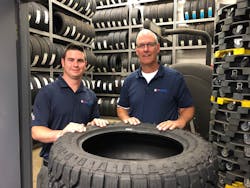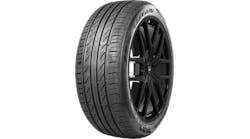How to Battle Big Box Stores, Maintain Margins and Survive a Pandemic: Three Questions With Tom and TJ White From Tire Source
With more than 30 years in the tire industry – including 28 operating Tire Source, an Akron, Ohio, area-based dealership with six locations across northeastern Ohio – Tom White has lived through a number of significant market developments, from the rise of big box retailers to the launch of tire manufacturer-owned e-commerce platforms and most recently, the economic shock of COVID-19.
MTD recently talked with Tom and his son, TJ White, who joined the company in 2010 and currently manages its Montrose, Ohio, store, to discuss how Tire Source has successfully competed against mass merchandisers.
They also detailed how Tire Source has held its ground in a world where tires are available through more channels than perhaps ever before. And they shared strategies that have enabled the dealership to survive – and even thrive – during the COVID-19 crisis.
MTD: Almost all of your stores operate within close range of big box stores and mass merchandisers that sell tires. Are these operations the threat that they once were and how have you managed to compete successfully against them?
Tom: Our customers are looking for a place where they can bring their cars and where they feel there are very qualified people changing their tires. Our people are very qualified at what they do. We keep up with state-of-the-art equipment. At the counter, our sales folks, our managers, our service managers – I think they have a better grasp of selling. They’re tire experts. They understand the product.
And we form that personal relationship with the customer. That’s our theme. We want to be partners with our customers. They want that extra care. Box stores don’t have that touch. They often don’t have the right tools. Sometimes, it becomes a hindrance for customers to go to a big box retailer.
TJ: From a store standpoint, what we notice the most when competing against the big box stores is price. People go there to get a price and then bring it to us and expect us to match it. In most cases, we get as close as we possibly can. But we also explain that we’re a local business and we’re going to do the best we can to serve them. I think if customers get into our store and realize we can offer them what they’re not necessarily going to find at a big box store, that makes their choice easier. We also have embraced online tire sales a little bit more, which helps. Customers can see our prices and know that we’re going to be very competitive.
Tom: One of the Walmarts around us, at the beginning of COVID-19, shut down the automotive service side of their operation. I think that caused them more angst than anything. And it really helped our store. It’s easy to make a customer unhappy in our industry. I don’t think big box stores have the same ‘care factor’ that we do.
TJ: We’ve seen that Walmart is going to pull out of auto service in Canada and it wouldn’t surprise me to see that in the U.S. within the next five to 10 years, as well.
Tom: If a shopper from a big box store can come into this environment and see the Tire Source way, they will become a Tire Source customer.
MTD: How have you successfully maintained margins in a world where tires are available through more sales channels than ever before, including online?
Tom: It’s like anything else. People are conscious of price, but they also want great service and value. We were one of the first dealers out there to embrace Goodyear’s ecommerce program. (Note: Goodyear Tire & Rubber Co. introduced its current e-commerce program in 2015.) It gives us a chance to earn a customer. What does it cost to win a new customer? A thousand dollars? We’re getting a customer for no out-of-pocket marketing. Once they come in and experience our environment, they become Tire Source customers. And we let them know about all the other services we offer. We normally don’t sell on price. We don’t want to be the highest. We don’t want to be the lowest. We make up for it with our service, our updated equipment and by having the best people in the industry.
TJ: Once a customer buys online, we want to get them in the store. As soon as they come in the store, it feels like a win for us. We know we’re going to provide excellent service for them and continue the relationship. Whether or not they decide to buy online the next time or they decide to give us that opportunity, we do our best to earn that customer’s business. On the margin side, we’re very adamant about making sure we offer in-house road hazard protection to every customer. It’s one of those things we try to add onto every package. And we’re able to help our margin in that sense.
Tom: The term I use is CFL: customers for life. That’s what we are looking for.
MTD: What was the most effective strategy you employed to survive the COVID-19 crisis and how did that make you a better, more efficient business?
Tom: I think the biggest thing we did was educate our people right away and let them know what was going on. I went to every store with our general manager, Pat Stuhldreher, and talked to everybody. At first, we thought we’d have to furlough people. I’m proud to say that we didn’t have to furlough one person. We were able to secure a Paycheck Protection Plan loan and that helped us immensely. We did all the normal things, too. We did a deep clean of all the stores. We put stickers on the floor with the Tire Source logo to keep people six feet apart. We’ve been extra-cautious with our credit card machines. We’re using steering wheel and gear shift covers. I think we have a pretty good grasp of safety precautions.
TJ: We also gave customers the ability to drop off their keys and leave their cars in the parking lot. A customer then can text any of our stores and the message will pop up on any computer in our stores, so almost every person in the shop can see that and respond to the customer. We can send customers information. They can ask questions. We send them a link to pay through their phone. They can pay with their credit card. They also can use Android or Apple Pay. We’ve gotten a lot of great feedback. And we plan on keeping almost everything that we’ve implemented during COVID-19.
Tom: We also made sure we had inventory on hand. We were probably at our highest inventory level at the beginning of COVID-19. It was kind of counter-intuitive that we were going to add inventory and drop cash down. But we kept a clean line of communication with our vendors. We didn’t have to dip into our cash reserves. We also have a line of credit, but we didn’t tap it right away. We dumped it into our bank account. We have great communication with our bank. Smaller dealers don’t always think about that sometimes. But let’s be honest: cash is king. I spend more of my time managing cash flow than anything else that I do.
Tire Source’s business has recovered robustly since the weeks immediately following the COVID-19 outbreak, according to Tom. “We’re just short of being 100%” of where the dealership was at the same time in 2019, he says. “We’re positioned and partnered right. We keep our showrooms neat and clean. Because of the virus, people are going to be looking at that. Barring a second wave of COVID-19, I think our better days are ahead.” ■
From first shovel to ribbon-cutting: MTD tracked birth of Tire Source's fourth store
Build it and they will come.” Those words, which were featured on the cover of the November 2002 issue of MTD (pictured), referred to the completion of Tire Source’s fourth store.
An article in that edition, written by then-MTD Editor Bob Ulrich, chronicled the development of the location, from the moment owners Tom White and Drew Dawson planted “opening soon” signs on the property — at the time, a vacant lot — to the store’s grand opening.
The article featured photos depicting each stage of the store’s development, plus commentary from both White and Dawson, which provide insight into their thought process at the time:
• “One of the hold-ups, time-wise, was negotiating the lease.”
• “Be as hands-on as the general contractor will let you. A couple of times we saw things we didn’t like and brought it to the attention of the general contractor.”
• “We negotiated with the developer to minimize our additional expenses.”
• “Tom and I like classic brick. It’s classy and timeless.”
“So many stores go up looking like Blockbuster video stores,” Dawson commented at the time. (Video rental chain Blockbuster went out of business in September 2010. At its peak in 2004, Blockbuster had more than 9,000 stores.)
“Our Montrose location is, by far, our biggest store,” Tom recently told MTD. “We built it and then other companies built around it. It’s in a good spot and we’re very happy with its location.”




